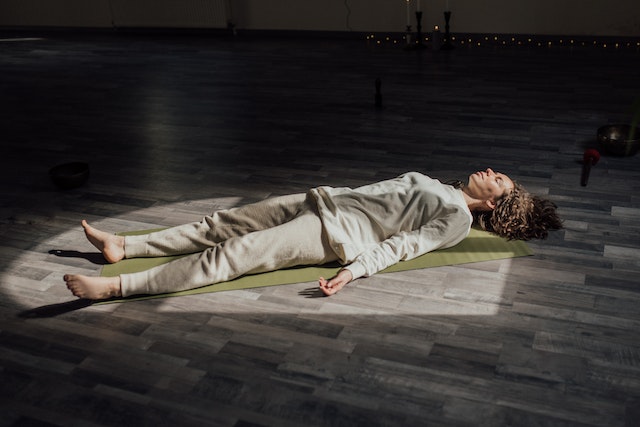Notice how you are sitting currently? Are you on a chair? How do your feet feel while sitting on the chair? Are they resting on the ground or swinging freely in the air? Are you able to feel your shoes or slippers touching your feet? What sensations can you feel in your feet? Are they restless, tingling, or aching?
You just started a basic form of body scan meditation.
Wondering how?
Body scan mediation is a mindfulness technique where instead of the generic focusing on your breath, you focus on the different sensations in your entire body. By directing your focus to different bodily sensations, body scan meditation helps you manage stress, anxiety, and pain.
So if you are ready to tune in and connect with yourself on a deeper, more profound level, stick around; in this post, we will dive deeper into what body scan meditation is, how it benefits your body and mind, and the proper steps to practice it. Let’s get started.

What Is Body Scan Meditation?
Body scan meditation is a form of mindfulness that mainly focuses on feeling your physical body. It involves scanning your entire body to find any sensations of pain, stress, or tension.
The main goals of body scan meditation are:
- gaining a better awareness of your bodily sensations,
- strengthening your connection to your physical body,
- learning to identify the signs of any physical discomfort, and
- enhancing your overall well-being by anticipating any stress-based discomfort.
What Are The Benefits Of Body Scan Mediation?
1. Treating Chronic Pain
As per a study published in the Journal of Behavioral Medicine, 10 minutes of body scan practice was able to help adults dealing with chronic pain. The technique is also a part of the eight-week mindfulness-based stress reduction program used to treat long-term illnesses like chronic pain.
2. Reducing stress and anxiety
In a study by Dana Schultchen and team, a body scan was able to reduce levels of cortisol or stress hormones in individuals. It was also found to reduce symptoms related to generalized anxiety disorder. Body scan meditation, therefore, improves your ability to deal with and manage stress and anxiety.
3. Enhancing sleep quality
Every mindfulness technique helps enhance sleep quality. However, going a step further, body scan can also help individuals with sleep disorders like insomnia. As per research by Eduard J. de Bruin and team, body scan meditation was able to significantly improve the benefits of behavioral therapy used to treat insomnia.
Read more: Guided Sleep Meditation For You – Fall Asleep In 2 Minutes
How To Practice Body Scan Meditation?
Body scan meditation can be practiced easily using the following steps:
1. Find a suitable environment: When practicing the body scan, it is important to choose a good, comfortable, and less cluttered environment. Surely, you can practice it anywhere, even during a few minutes of office scan. But having a space for more extended body scan meditation will help you reap the maximum benefits.
2. Get into a comfortable position: When most people think of meditation, they think of the traditional pose of sitting cross-legged on the ground. Albeit good, you can soon get uncomfortable in this position. Therefore, for a body scan, you get into any comfortable position you like. For example, you can lie on the ground or sit on a chair or couch.
3. Close your eyes, take a few breaths, and try to be still: Once you get into your most comfortable position, take a few deep breaths and close your eyes. Try to relax your body. This will help you dissociate from the rest of the environment.
4. Focus on your body: Now, try to bring your breathing to a normal rhythm. Since the body scan is not directed toward focusing on your breathing, allow your breath to return to its normal pace. In the next step, start focusing on your body.
Initially, bring your attention to your whole body rather than a single part. Notice the position you are in. Think of how your body feels right now. Pay more attention to body parts in contact with things like the mat, rug, chair, or floor you are sitting or lying on.
5. Start scanning your body: Now that you have more understanding of how your body feels, you can start the actual process of scanning your body. Start with the crown of your head, and scan each and every body part right up to your feet. Explore all the sensations you feel in each part. Alternatively, you can also go from your feet to your head if that feels more comfortable to you.
6. If your mind wanders around, try to refocus on the body scan: We are not meditation masters; therefore, it is okay if your mind starts to wander somewhere else. Try to recentre your attention your body if this happens.
7. Take your body as a whole: Now that you have finished feeling your body part by part. Once again, take your body as a whole and see how it feels.
Finally, take a few deep breaths and open your eyes to conclude the practice.
Read more: Meditation For The Modern Age – Headspace App Review
Conclusion:
Body scan meditation is a form of mindfulness that focuses on your sensory experience to alleviate stress, anxiety, pain, and sleeping issues. We hope this post will help you get started with body scan meditation right away.
Apart from body scan, there are multiple forms of guided meditation techniques that can help you find what Master Shifu in Kung Fu Panda so desperately desired – inner peace. To learn more about these meditation techniques, click here.
To continue learning about mindfulness and mental health, subscribe to Your Mental Health Pal.

